Once You’re In, You’re In For Life
May – June 2020
The Mob Museum in Las Vegas is the one museum you can’t resist.
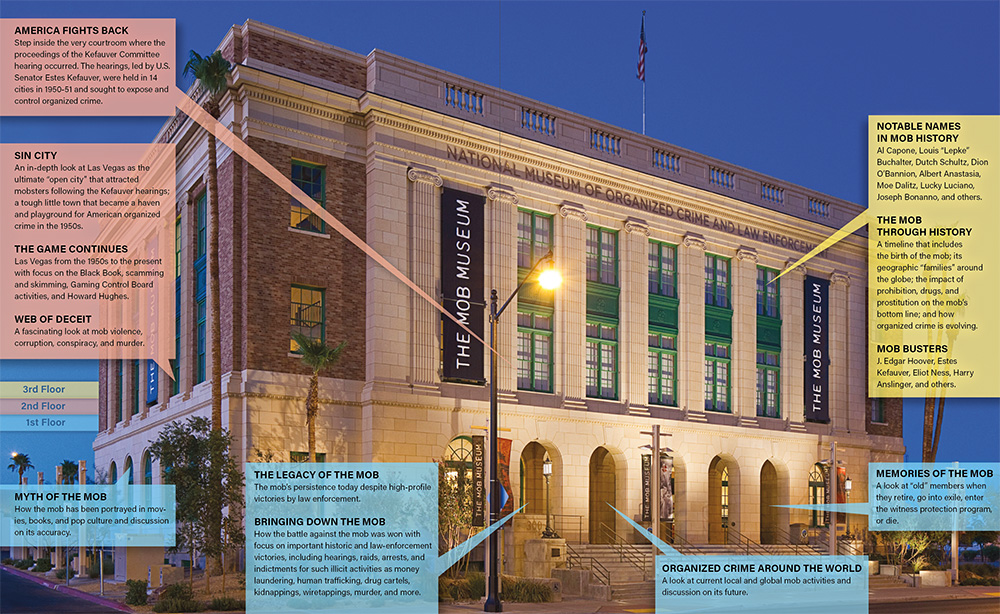
BY MEGG MUELLER
Going to Las Vegas to visit a museum might have once sounded as foolish as trying to sell ice cubes to Eskimos. It’s not that the town is culturally bereft; far from it. From sunken objects recovered from the Titanic to Carroll Shelby’s gleaming machines—not to mention the wealth of historical, cultural, and incredible artifacts at the state museums—Las Vegas has long had its fair share of educational diversions.
The city also had its share of historical diversions during its growth, and none has been quite so infamous as Las Vegas’ connection to the mob. The glitz and glamour of the burgeoning gambling town was too great a lure for organized crime, and the two became inextricably linked. Today, that link is why it’s not unusual for people to travel to Las Vegas to visit The Mob Museum.
Housed inside the former post office and federal courthouse built in Downtown Las Vegas in 1933, the National Museum of Organized Crime and Law Enforcement—affectionately called The Mob Museum—is a glorious and fascinating look at the world of mobsters and cops. The story of these two factions is covered from the roots of the mob in the U.S. in the early 1900s to present-day global crime syndicates.
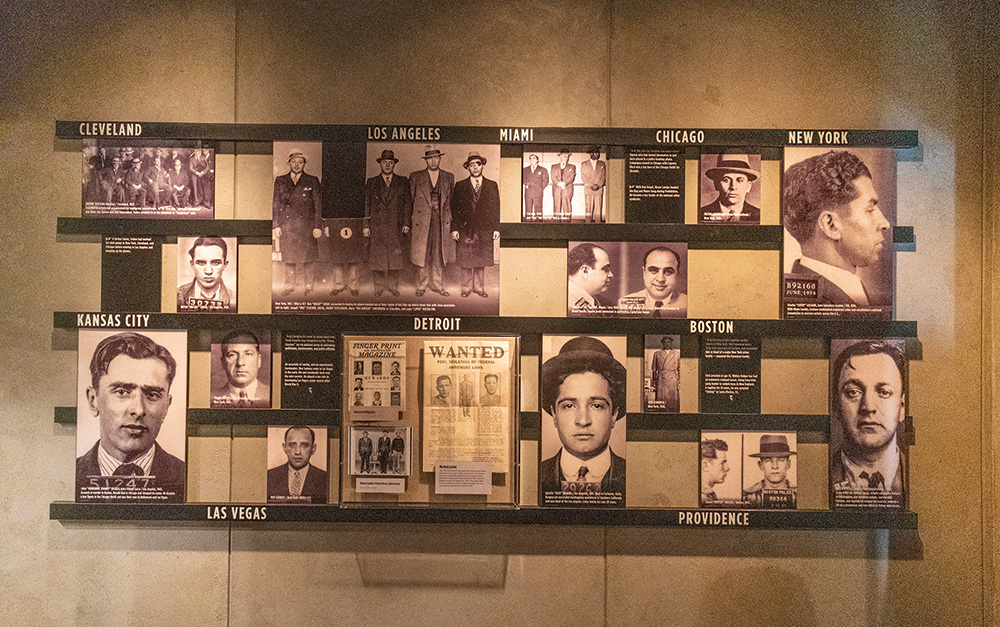
WISE GUYS
The story of how the museum came to be is just as interesting as the story told within the walls. In the early 2000s, the federal government decided the city didn’t need three courthouse buildings. With the caveat that it must be refurbished and house a cultural entity, an offer was made that the city couldn’t refuse; they could own the building for $1. Then-Mayor of Las Vegas Oscar Goodman jumped at the chance.
Mayor from 1999-2011, Goodman had made a name for himself as a defense attorney for reputed mobsters Meyer Lansky, Anthony Spilotro, and Frank Rosenthal, among others. It didn’t take him long to come up with the idea for the building—where he had tried his first federal case—to be home to a museum about the history of the mob.
“Certainly part of it was he knew he knew guys, and he knew he had access to some artifacts, but it’s also clearly a big part of the Las Vegas story,” explains Claire White, educational programs manager at the museum. “It took a bit of time. When he first suggested it there were many concerns at the city level, and editorials written. People didn’t want it to glorify the mob. But he took care of that by telling both the mob and the law enforcement stories. It’s an important story and it’s extremely fascinating.”
Goodman retained the services of the former head of the FBI office in Las Vegas, with the blessing of the Bureau in Washington, D.C., which also provided some memorabilia for the museum.
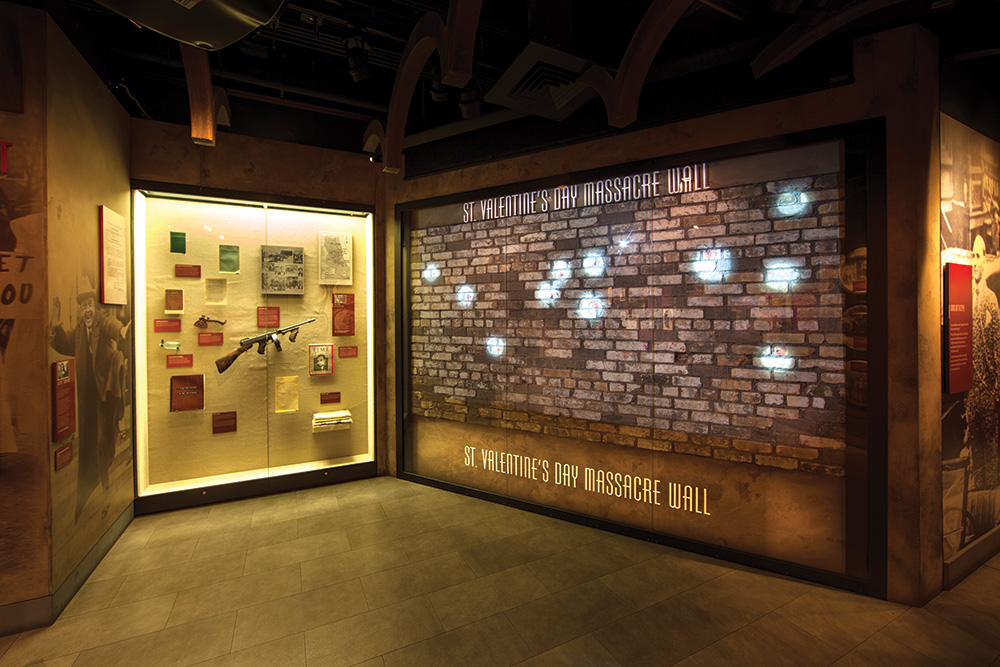
IF THESE WALLS COULD TALK
The museum opened on Valentine’s Day in 2012, an auspicious day because one of the most popular exhibits in the museum is the St. Valentine’s Day Massacre Wall. Seven members of Chicago’s North Side Gang were lined up against a brick wall in a garage on Feb. 14, 1929, and mowed down by shotguns and submachine guns. While as many as 14 bullet wounds were found in the victims, many bullets were pulled from the wall also. The garage never recovered as a business, and in 1967 it was torn down. A savvy businessman bought the bricks from the fateful wall, and each one was marked so the wall could be recreated. Today, that wall exists at the Mob Museum.
Along with photos from the crime scene, forensic evidence gathered by the coroner’s office, and other artifacts, the recreated wall is a sobering and fascinating look at one of the most violent aspects of organized crime. It is the centerpiece of the museum’s third floor, and easily the most important artifact aside from the building itself, Claire mentions. She also recommends tours begin on the third floor and work down.
“We begin with the birth of the mob and go to about the 1950s. The exhibits look at the issues that brought people into organized crime,” she explains. “We don’t want people to think that organized crime is just about certain ethnic groups, but the reality is the beginning of organized crime in the U.S. looked like Italian, Irish, and Eastern Europe Jewish immigrants. These people faced extreme discrimination. They or their parents came here thinking they’d find a better life, and instead many found tenements, with no windows, no indoor plumbing.”
The museum brings the rise of organized crime to life with stories, artifacts, photos, and interactive media. Tales of police officers trying to fight the influx of criminal activity and how law enforcement techniques grew along with the mob are told in a variety of mediums, from videos to maps showing the spread of crime in the early 1900s. Visitors can even stand in a lineup with one-way glass and have their photo taken by a museum photographer as a keepsake. The combination of deeply interesting educational material and interactive exhibits makes the museum a truly exciting learning experience.

CRIMINALS AT THE DOOR
The second floor still houses the federal courtroom where the Kefauver hearing was held in the 1950s. Senator Estes Kefauver held 14 hearings across the U.S. to expose organized crime, and one hearing was held in the now-beautifully restored courtroom at the museum.
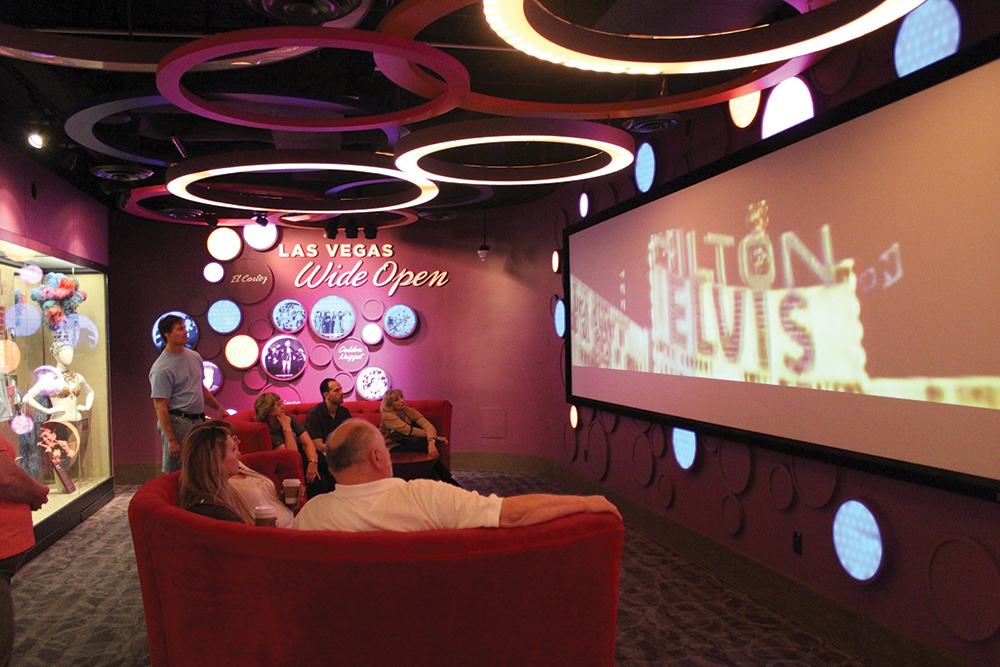
“Open City” is another second floor exhibit. It discusses Las Vegas’ growth in the 1940s-50s and the allure the city held for organized crime. Mobsters from across the country flocked to Vegas to make it rich, and it wasn’t until 1960 that the state gaming control board created its so-called Black Book. The book’s names were of people with any known criminal connection, and these people then could not be an executive at a casino that has any connection to the gaming industry, Claire explains.
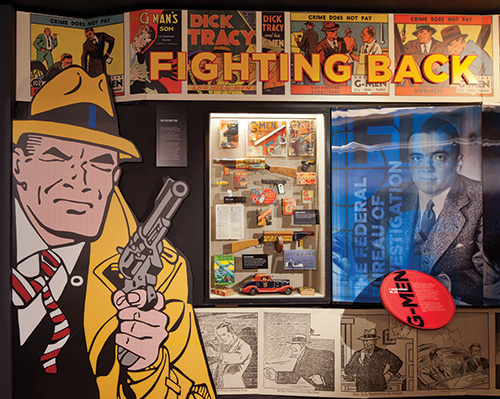 The museum shows just how easy that was to get around, however. Learn about skim rooms and the tens of millions of dollars that were smuggled out of Nevada, and how creative gangsters like Moe Dalitz and Joe Agosto continued working in casinos long after the Black Book came out. Clark County Sherriff Ralph Lamb has his own exhibit, highlighting the lawman’s importance to southern Nevada.
The museum shows just how easy that was to get around, however. Learn about skim rooms and the tens of millions of dollars that were smuggled out of Nevada, and how creative gangsters like Moe Dalitz and Joe Agosto continued working in casinos long after the Black Book came out. Clark County Sherriff Ralph Lamb has his own exhibit, highlighting the lawman’s importance to southern Nevada.
Throughout the museum, the role of law enforcement is given equal measure. Claire notes that, in reaction to the antics of organized crime, police tactics evolved.
“Law enforcement learned and grew right along with the mob,” Claire says. “Many techniques learned in the early years are still being used today.”
A MORE MODERN MOB
The museum’s first floor is a summary from 1957 to present day, and the very real truth that organized crime isn’t swimming with the fishes.
“It’s very important to us to tell the full story, so that we incorporate international organized crime that is affecting us today,” Claire explains. “Two areas we are focusing on are wildlife-trafficked products and counterfeit products. Our goal is to make people think about the finances behind organized crime. It’s very subtle.”
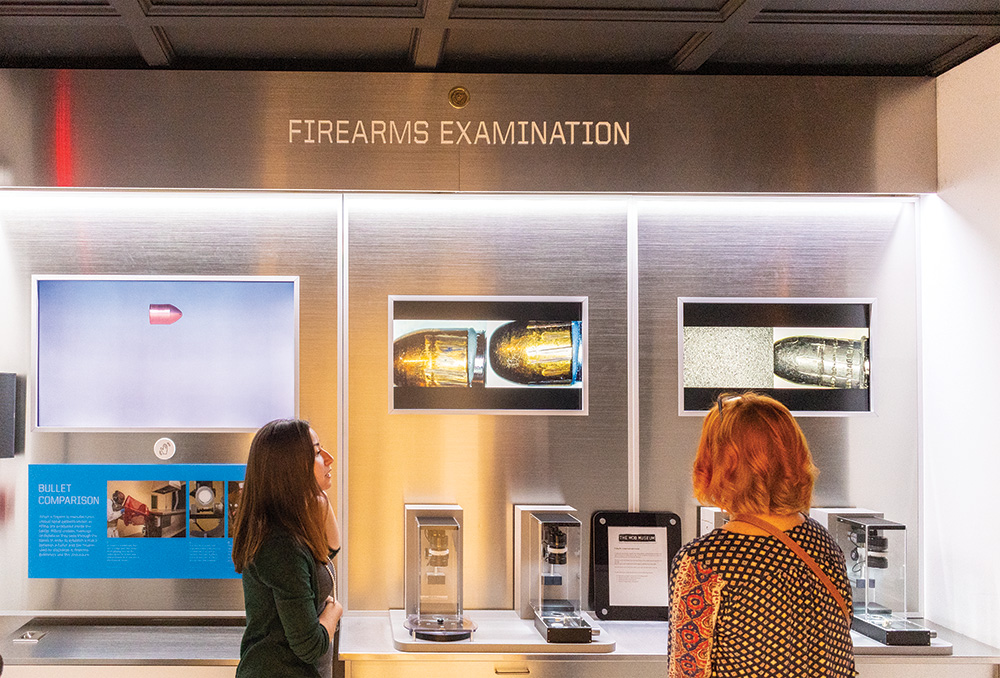
Staying with the modern theme, separately-ticketed events such as the Crime Lab, The Use of Force Experience, and the Firearm Training Simulator, give visitors a very real, hands-on way of learning about how crime is being fought today. From doing virtual autopsies to studying fingerprint patterns and even making decisions on the use of deadly force, these opportunities bring the world of law enforcement to life and are not to be missed.
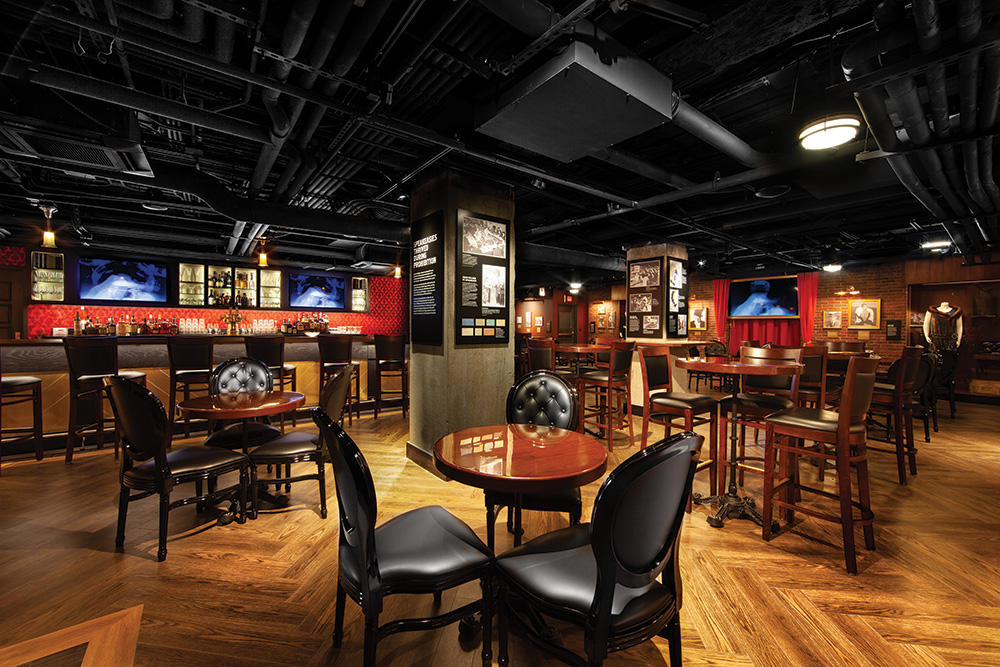
WHAT’S THE PASSWORD?
If there ever was a defining time in the advent of the mob, it was Prohibition. Mobsters became millionaires from the 1920s to 1933, and alcohol was the reason. Leaving no corner of the mob experience unturned, the museum opened The Underground in its basement in 2018. The history of Prohibition is on display along with a speakeasy, working distillery, and plenty of artifacts from that time period, including the phone booth that was in the Four Deuces Club on Chicago’s south side, which Al Capone used as his office.
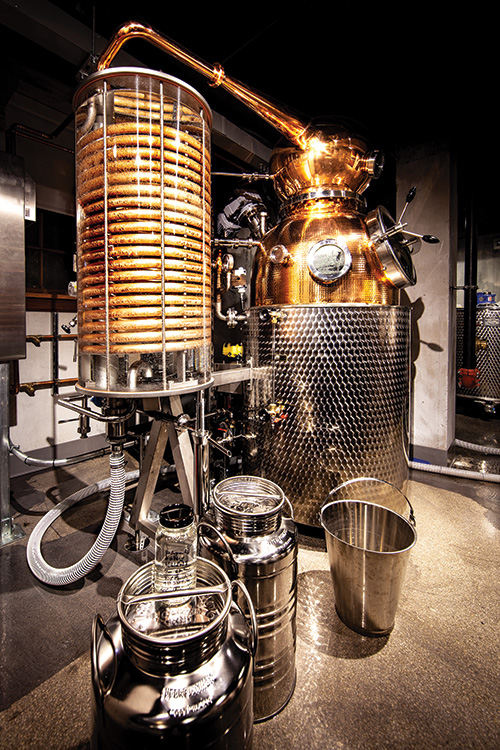 Watching the custom-made copper still drip with high-proof, 100-percent yellow corn moonshine adds a touch of irony to the ever-present facts and photos that fill the distillery. Same with the jazz-era clothing and Tommy gun displayed in the speakeasy; no detail goes unnoticed or is unwarranted. The commitment to education is consistent and yet unobtrusive; the museum fascinates and illuminates without ever feeling musty or overwhelming.
Watching the custom-made copper still drip with high-proof, 100-percent yellow corn moonshine adds a touch of irony to the ever-present facts and photos that fill the distillery. Same with the jazz-era clothing and Tommy gun displayed in the speakeasy; no detail goes unnoticed or is unwarranted. The commitment to education is consistent and yet unobtrusive; the museum fascinates and illuminates without ever feeling musty or overwhelming.
The museum is a 501(c)3 nonprofit organization with a mission to give back to the community as often as possible. Educational outreach programs for schools and community safety programs have existed since it opened, and today the public outreach continues to grow.
Geoff Schumacher, senior director of content for the museum, says in 2019 there were 94 public programs, and that ambitious programming is planned going forward.
“We have a program series called The Science of Crime that we actually hold in the exhibit space, with room for about 30 chairs,” he explains. “It’s about how to solve crimes, and we have experts come speak. On June 11, we are planning a courtroom conversation on the 60th anniversary of the Black Book. We plan to have a panel discussion involve members of the state gaming control board, as well as Oscar Goodman.”
Along with the discussions, the museum hosts movie screenings. In honor of the 60th anniversary of the original “Oceans 11” movie—which premiered Aug. 3, 1960, just blocks from the museum—the film will be screened in August. In September, it’s the 30th anniversary of “Good Fellas” and November will mark the 25th anniversary of “Casino.” Geoff notes they are looking to invite the “Casino” cast and crew to the showing.
Twice each year, locals are offered free admission on two poignant dates in the museum’s history—Valentine’s Day and Nov. 15, the anniversary of the Kefauver hearing. The museum also has a free app with visitor information, maps, and exhibits, and just for fun (and to learn something), app users can search a database of some 800 key figures to find a lookalike from the world of organized crime and law enforcement. It’s just one more way the museum’s mission is to advance the public’s understanding of organized crime in America, and law enforcement, as well. The fact that they do it in such an entertaining and engaging manner makes the Mob Museum the capo dei capi.

